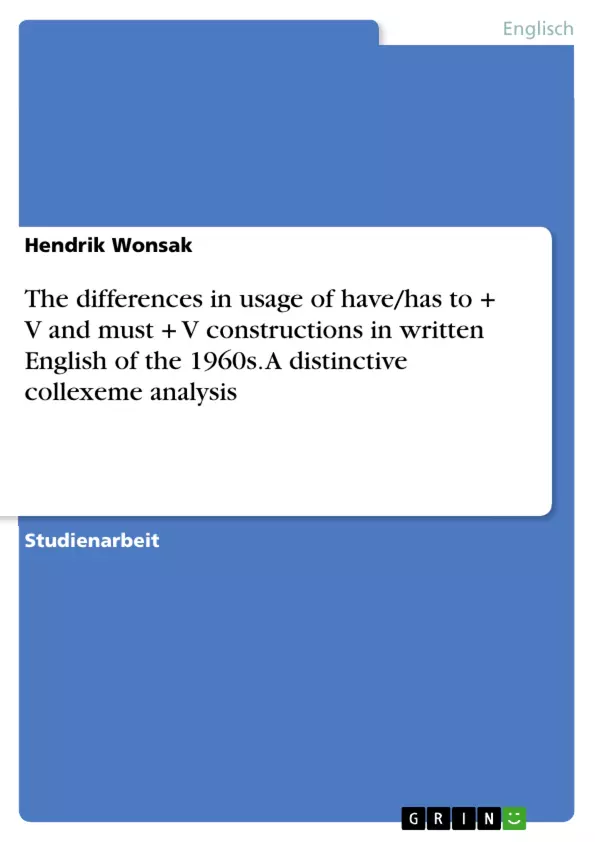Do I have to write this term paper or must I? Is there even a semantic difference between the two constructions have/has to + V and must + V? Epistemically, there is little diference between the two constructions, but a deontic approach shows that the construction must + V obliges the subject of the sentence to do something, while the construction have/has to + V does not play a strong deontic role. Nevertheless, native speakers of the English language use both constructions more or less indiscriminately.
This term paper rejects the common approach that the two constructions are semantically identical, since certain verbs are more likely to occur in the have/has to + V-construction, than in the must + V-construction.
According to Gries and Stefanowitsch, traditional linguistic studies view the lexicon and the grammar of a language as two completely diferent phenomena. In their cited publication, they state that “various expression types that fall somewhere in between lexicon and grammar have been recognized but largely ignored by mainstream syntactic theories” (Gries & Stefanowitsch, 2003, 209). Over the past decades, however, a variety of linguists, such as Lewis Hunston, Sinclair, Gries and Stefanowitsch themselves, have published a variety of theories, which approach a diferent view towards the connections between grammar and lexicon. These theories assume that “grammar and lexicon are not fundamentally diferent, and that the long-ignored multi-word expressions serve as an important link between them” (Gries & Stefanowitsch, 2003, 210).
Following these theories, pairs of semantically more-or-less corresponding expressions and constructions, as the ones shown in (1) to (3), have occupied the attention of linguists all over the world (Gries & Stefanowitsch, 2004, 97):
(1) Peter gave Mary the ball / Peter gave the ball to Mary
(2) Frank is going to be happy / Frank will be happy
(3) Peter must give Mary the ball / Peter has to give Mary the ball
Inhaltsverzeichnis
- Introduction
- Theoretical background
- Collostructional analysis
- Distinctive collexeme analysis
- Method
- Database and CQL search
- Collexeme analysis of have/has to + V construction
- Collexeme analysis of must + V construction
- Distinctive collexeme analysis of have/has to + V and must + V constructions
- Conclusion
Zielsetzung und Themenschwerpunkte
Diese Arbeit untersucht die Verwendung der Konstruktionen have/has to + V und must + V im geschriebenen Englisch der 1960er Jahre. Ziel ist es, mithilfe einer distinktiven Kollememanalyse herauszufinden, ob es signifikante Unterschiede in der Verwendung dieser Konstruktionen gibt, obwohl sie semantisch ähnlich erscheinen.
- Die Beziehung zwischen Grammatik und Lexikon
- Die Kollostructional Analysis als Forschungsmethode
- Distinktive Kollememanalyse als Teil der Kollostructional Analysis
- Die Verwendung von have/has to + V und must + V im geschriebenen Englisch der 1960er Jahre
- Die Analyse von Kollokationen und ihrer Bedeutung
Zusammenfassung der Kapitel
- Introduction: Die Einleitung stellt die Thematik der Arbeit vor und skizziert die Forschungsfrage. Sie beleuchtet die unterschiedlichen Sichtweisen auf die Beziehung zwischen Grammatik und Lexikon und die Bedeutung der Kollostructional Analysis.
- Theoretical background: Dieses Kapitel erläutert die grundlegenden Konzepte der Kollostructional Analysis und der distinktiven Kollememanalyse. Es werden die Methoden und Techniken vorgestellt, die für die Analyse von Kollokationen und die Untersuchung von Konstruktionsbeziehungen verwendet werden.
- Method: Das Methodenteil beschreibt die verwendete Datenbank (Brown Corpus) und die angewandten Suchmethoden (CQL). Es stellt den Ablauf der Analyse von have/has to + V und must + V Konstruktionen dar, einschließlich der verwendeten Statistiken und Berechnungen.
Schlüsselwörter
Die Arbeit konzentriert sich auf die Kollostructional Analysis, die distinktive Kollememanalyse, Kollokationen, have/has to + V Konstruktionen, must + V Konstruktionen, das Brown Corpus und das geschriebene Englisch der 1960er Jahre. Sie untersucht die Verwendung dieser Konstruktionen im Kontext der englischen Sprache der 1960er Jahre und ihre Beziehung zu bestimmten Verben (Kollemen).
- Quote paper
- Hendrik Wonsak (Author), 2016, The differences in usage of have/has to + V and must + V constructions in written English of the 1960s. A distinctive collexeme analysis, Munich, GRIN Verlag, https://www.hausarbeiten.de/document/353947


